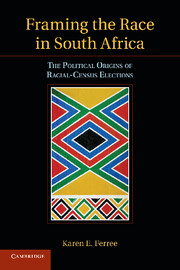Book contents
- Frontmatter
- Contents
- List of Tables
- Acknowledgments
- 1 Introduction
- 2 Voters
- 3 The 1994 Campaigns
- 4 The 1999 Campaigns
- 5 The 2004 Campaigns
- 6 Can a Leopard Change Its Spots? Candidate Demographics and Party Label Change
- 7 Why So Slow? The Political Challenges of Candidate Transformation for Opposition Parties
- 8 Negative Framing Strategies and African Opposition Parties
- 9 Conclusion: South Africa in Comparative Perspective
- References
- Index
- Titles in the series
3 - The 1994 Campaigns
Published online by Cambridge University Press: 06 December 2010
- Frontmatter
- Contents
- List of Tables
- Acknowledgments
- 1 Introduction
- 2 Voters
- 3 The 1994 Campaigns
- 4 The 1999 Campaigns
- 5 The 2004 Campaigns
- 6 Can a Leopard Change Its Spots? Candidate Demographics and Party Label Change
- 7 Why So Slow? The Political Challenges of Candidate Transformation for Opposition Parties
- 8 Negative Framing Strategies and African Opposition Parties
- 9 Conclusion: South Africa in Comparative Perspective
- References
- Index
- Titles in the series
Summary
Chapter 2 established the centrality of racial credentials to persuasion in South Africa. It demonstrated that party images, which are rooted in the country's apartheid past, powerfully shape African voting behavior. The remainder of the book focuses on the process of party image change. If party images are the lynchpin to persuasion in South Africa, have the opposition parties attempted to change their images in a way that would make them more attractive to the electorate? If they have, what strategies have they used? And, finally, why have they not been more successful?
In this and the following chapters, I will show that the opposition parties in South Africa have understood the link between party labels and persuasion and made extensive efforts during the 1994–2004 period to transform themselves from “white” parties to multiracial ones. They faced daunting challenges in this process, however. For as much as opposition parties have wished to transform their images, the ANC has wanted to preserve them, thereby preventing the emergence of viable competitors for the African vote. The party images of the opposition have therefore formed a central battleground in South Africa's post-apartheid electoral landscape, one in which the ruling party has outplayed the opposition.
In this chapter, I focus on the campaigns of the ANC, NP, and DP during the first post-apartheid election, held April 27, 1994.
- Type
- Chapter
- Information
- Framing the Race in South AfricaThe Political Origins of Racial Census Elections, pp. 65 - 81Publisher: Cambridge University PressPrint publication year: 2010

